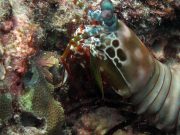Dykning med Slående Mantisräka
Lanta Marina Liv | Odontodactylidae
Slående Mantisräka är varken räkor eller mantis, de är en separat grupp av 450 arter som kallas stomapods. De finns vid alla våra korallrev, men är inte alltid lätta att få syn på under dykresorna på Koh Lanta.
Med ett tjockt skal som täcker bakhuvudet och de fyra första segmenten av huvudkroppen är de bland de mest effektiva kräftdjursrovdjuren. Denna grupp av djur blir vanligtvis 10-15 cm långa och har några av de mest komplexa ögonen i världen, inklusive förmågan att se polariserat ljus.
Slående mantisräka har två specialiserade förkalkade 'smashing clubs' längst fram på kroppen som används för att krossa krabb- och musselskal med över 50 km/h på bara en bråkdel av en sekund, och är kända för att spricka och slå hål i akvarieglas.
Slående mantisräka är solitära och territoriella varelser som gör hålor i hård havsbotten eller korallhålor som används som platser för parning och för att hålla sina ägg säkra.
1 arter finns på denna sida:
Peacock Mantis Shrimp
(Odontodactylus scyllarus)
The Peacock Mantis Shrimp has an olive-tan to dark green body (the males are dark green). The antennae are yellow-orange to green. The eye stalks are pale bluish and the eyes are a greyish colour. The front side of the carapace (shell) is whitish with dark blotches. Further behind the head and body segments, the carapace is mottled tan to greenish to grey, with lighter blotches, spots and stripes.

Odontodactylus scyllarus @ Koh Haa
The Peacock Mantis Shrimp grows to 18 cm and has the most sophisticated vision and fastest strike of any predator on earth. The eyes work both together and independently to target prey and can detect more colours than any creature on earth, including polarised light.
The Peacock Mantis Shrimp is a Smashing Mantis, armed with two spring loaded hammer claws. The strike is up to 23 m per second (50 times faster than the blink of a human eye). When striking prey, for a moment, the surrounding water reaches the temperature of the surface of the sun (yes, really!).
The Peacock Mantis Shrimp builds its burrow in rocky and coral nooks and crannies and often hunts away from the burrow.
Dykning med Slående Mantisräka runt Koh Lanta
Dykning och Snorkelutflykter
Om du vill ha en chans att se Slående Mantisräka på en av våra dagliga högsäsongs dykresor från Koh Lanta, skicka oss ett e-postmeddelande till info@diveandrelax.com.
Följ med på våra dykresor med speedboat under högsäsong till några av Thailands bästa dykplatser och njut av små grupper, korta restider och fokus på personlig service, säkerhet och nöje.
Är du ännu inte certifierad dykare? Lär dig att dyka på Koh Lanta med den 3-dagars SSI Open Water Diver-kursen.
Boka online och spara 10 % på dykresor och dykkurser på Koh Lanta.
Ta Reda på Mer
Guider för Marina Djur och Växter i Indo-Stilla Havet
- Allen, G., Steene, R., Humann, P., DeLoach, N. (2003) Reef Fish Identification, Tropical Pacific. Jacksonville, FL., USA: New World Publications, Inc., ISBN 1-878348-36-1.
- Humann, P., DeLoach, N., (2010) Reef Creature Identification, Tropical Pacific. Jacksonville, FL., USA: New World Publications Inc., ISBN 978-1-878348-44-9
- Debelius, H. (2013) Indian Ocean Reef Guide. Frankfurt, Germany: IKAN - Unterwasserarchiv, ISBN 978-3-939767-52-7.
- Debelius, H. (2004) Nudibranchs and Sea Snails, Indo-Pacific Field Guide. Frankfurt, Germany: IKAN - Unterwasserarchiv, ISBN 3-925919-51-1
- Erhardt, H., Knop, D. (2015) Corals Indo-Pacific Field Guide. Frankfurt, Germany: IKAN - Unterwasserarchiv, ISBN 3-925919-69-4.
- Veron J.E.N., Stafford-Smith M.G., Turak E. and DeVantier L.M. (2016). Corals of the World


